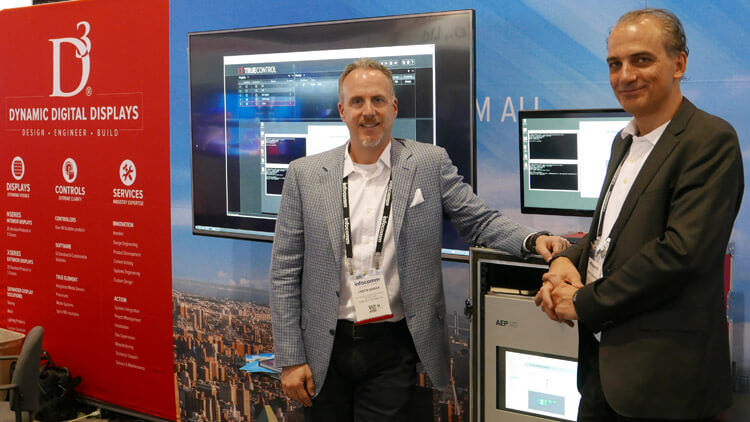- In a world– and an InfoComm show– with an explosion of direct view LED displays, InfoComm 2017 is probably a good place to ask “great displays– but how do you feed content to all those pixels?” The “resolution” of direct view LED is simple: it’s whatever resolution you want it to be. Unlike the flat panel LCD panels so ubiquitous in the “digital signage” market, or in video projection, the resolution of your image depends on how much real estate, “screen” size, you build. You could do 4K with 20mm pixel pitch LED– if you had a screen size big enough. And in fact, out in the wild, we are now seeing so many different pixel pitch configurations and so many different sizes, shapes, and permutation of LED walls that it is now becoming something of a puzzle figuring out the best way to get content out to all those screens without cobbling together a patchwork of scalers, media servers, and other content delivery tools that just add layers of complexity to the installation.
Jason Barak (left), and Meric Adriansen of D3 (booth 874 at InfoComm in Orlando this week), showing D3’s new AEPIMS Pro- a media server with capabilities not previously available anywhere, for driving large scale, hi res LED video walls: a single processor capable of driving up to 16k x 16k resolution, with real-time scaling and compositing, and more.
So with that background, here at InfoComm 2017 in Orlando, where LED suppliers big and small– including Leyard/Planar, Samsung, SiliconCore, Sony, Unilumen, Daktronics, NEC, Christie, LG, Barco, Nanolumens, Dynascan, and more are showing a wide of variety of LED panels– are dazzling the crowds with high brightness LED, you get back to question: is there an easier way to get content from multiple sources, in multiple formats and in many different original “resolutions”, out to multiple LED screens of different shapes and resolutions? To date it’s not been easy to do that– at both ends of the application spectrum: either efficiently managing the content delivery to a super high res LED video wall at one resolution that sucks up tens of millions of pixels worth of content, or managing the content delivery to an application that features pixels spread over different screens at different resolutions. For the former, imagine having to efficiently serving up content to an 80-foot, 13K resolution LED video wall in the lobby of the Netflix HQ in Los Angeles. (Doing some math on the size of the screen X the pixel pitch, thats 100,000,000 pixels to Netflix, all at once, for one screen. ) For the latter: serving up a mix of content, to different screens at different resolutions, to the sets of the CBS Late Show with Stephen Colbert and also for the Today Show on NBC.At the D3 booth (#874) at InfoComm in Orlando this week, Meric Adriansen and Jason Barak of D3 are explaining how their company did all that, and how their AEPIMS Pro– a “media server” (quotes because it’s not your father’s media server) with capabilities beyond what typical media servers can do– is allowing content creators and brands and corporate end users to get the highest resolution content imaginable out there. But it’s not just about high res content. It’s about making a server that can push out and manage content of all resolutions in a way that avoids having to cobble together (and render) different format content at the get go in the content creation process, then different format/resolution feeds to different screens in a venue. All with one hardware/software solution. It’s worth checking out– after you’ve been dazzled by all the LED walls of all sizes and resolutions on the show floor. You’ve probably never seen case studies and gear about getting so much content to so many pixels with such little fuss.










